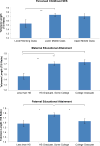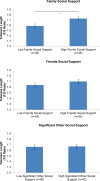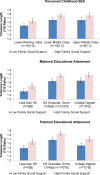Childhood adversity, social support, and telomere length among perinatal women
- PMID: 29035711
- PMCID: PMC5705286
- DOI: 10.1016/j.psyneuen.2017.10.003
Childhood adversity, social support, and telomere length among perinatal women
Abstract
Adverse perinatal health outcomes are heightened among women with psychosocial risk factors, including childhood adversity and a lack of social support. Biological aging could be one pathway by which such outcomes occur. However, data examining links between psychosocial factors and indicators of biological aging among perinatal women are limited. The current study examined the associations of childhood socioeconomic status (SES), childhood trauma, and current social support with telomere length in peripheral blood mononuclear cells (PBMCs) in a sample of 81 women assessed in early, mid, and late pregnancy as well as 7-11 weeks postpartum. Childhood SES was defined as perceived childhood social class and parental educational attainment. Measures included the Childhood Trauma Questionnaire, Center for Epidemiologic Studies-Depression Scale, Multidimensional Scale of Perceived Social Support, and average telomere length in PBMCs. Per a linear mixed model, telomere length did not change across pregnancy and postpartum visits; thus, subsequent analyses defined telomere length as the average across all available timepoints. ANCOVAs showed group differences by perceived childhood social class, maternal and paternal educational attainment, and current family social support, with lower values corresponding with shorter telomeres, after adjustment for possible confounds. No effects of childhood trauma or social support from significant others or friends on telomere length were observed. Findings demonstrate that while current SES was not related to telomeres, low childhood SES, independent of current SES, and low family social support were distinct risk factors for cellular aging in women. These data have relevance for understanding potential mechanisms by which early life deprivation of socioeconomic and relationship resources affect maternal health. In turn, this has potential significance for intergenerational transmission of telomere length. The predictive value of markers of biological versus chronological age on birth outcomes warrants investigation.
Keywords: Childhood SES; Childhood trauma; Pregnancy; Social support; Telomeres.
Copyright © 2017 Elsevier Ltd. All rights reserved.
Conflict of interest statement
Figures



Similar articles
-
Sex differences in effects of maternal risk and protective factors in childhood and pregnancy on newborn telomere length.Psychoneuroendocrinology. 2018 Sep;95:74-85. doi: 10.1016/j.psyneuen.2018.05.025. Epub 2018 May 17. Psychoneuroendocrinology. 2018. PMID: 29803183 Free PMC article.
-
The joint contribution of maternal history of early adversity and adulthood depression to socioeconomic status and potential relevance for offspring development.J Affect Disord. 2017 Jan 1;207:26-31. doi: 10.1016/j.jad.2016.08.012. Epub 2016 Aug 16. J Affect Disord. 2017. PMID: 27685851
-
Racial Discrimination and Telomere Length in Midlife African American Women: Interactions of Educational Attainment and Employment Status.Ann Behav Med. 2021 Jun 28;55(7):601-611. doi: 10.1093/abm/kaaa104. Ann Behav Med. 2021. PMID: 33289498 Free PMC article.
-
A systematic review on the effects of social discrimination on telomere length.Psychoneuroendocrinology. 2020 Oct;120:104766. doi: 10.1016/j.psyneuen.2020.104766. Epub 2020 Jun 13. Psychoneuroendocrinology. 2020. PMID: 32603955
-
Stress and telomere biology: a lifespan perspective.Psychoneuroendocrinology. 2013 Sep;38(9):1835-42. doi: 10.1016/j.psyneuen.2013.03.010. Epub 2013 Apr 29. Psychoneuroendocrinology. 2013. PMID: 23639252 Free PMC article. Review.
Cited by
-
Turning stress into success: A festschrift in honor of Janice Kiecolt-Glaser.Compr Psychoneuroendocrinol. 2024 Jul 23;19:100251. doi: 10.1016/j.cpnec.2024.100251. eCollection 2024 Aug. Compr Psychoneuroendocrinol. 2024. PMID: 39170082 Free PMC article. No abstract available.
-
Adverse Childhood Experiences and Telomere Length a Look Into the Heterogeneity of Findings-A Narrative Review.Front Neurosci. 2019 May 22;13:490. doi: 10.3389/fnins.2019.00490. eCollection 2019. Front Neurosci. 2019. PMID: 31191214 Free PMC article.
-
Oxytocin administration prevents cellular aging caused by social isolation.Psychoneuroendocrinology. 2019 May;103:52-60. doi: 10.1016/j.psyneuen.2019.01.006. Epub 2019 Jan 8. Psychoneuroendocrinology. 2019. PMID: 30640038 Free PMC article.
-
Association of Parental Socioeconomic Status and Newborn Telomere Length.JAMA Netw Open. 2020 May 1;3(5):e204057. doi: 10.1001/jamanetworkopen.2020.4057. JAMA Netw Open. 2020. PMID: 32364595 Free PMC article.
-
The role of optimism, connectedness, and neighborhood collective efficacy as moderators of harsh parenting on telomere length.Psychoneuroendocrinology. 2025 Apr;174:107373. doi: 10.1016/j.psyneuen.2025.107373. Epub 2025 Jan 28. Psychoneuroendocrinology. 2025. PMID: 39978211 Free PMC article.
References
-
- Barger SD, Cribbet MR. Social support sources matter: Increased cellular aging among adults with unsupportive spouses. Biological Psychology. 2016;115:43–49. - PubMed
-
- Bernstein DP, Stein JA, Newcomb MD, Walker E, Pogge D, Ahluvalia T, Stokes J, Handelsman L, Medrano M, Desmond D. Development and validation of a brief screening version of the Childhood Trauma Questionnaire. Child Abuse & Neglect. 2003;27:169–190. - PubMed
-
- Biron-Shental T, Sadeh-Mestechkin D, Amiel A. Telomere homeostasis in IUGR placentas-A review. Placenta. 2016;39:21–23. - PubMed
-
- Blackburn EH. Telomeres and telomerase: Their mechanisms of action and the effects of altering their functions. FEBS letters. 2005;579:859–862. - PubMed
MeSH terms
Grants and funding
LinkOut - more resources
Full Text Sources
Other Literature Sources
Medical

